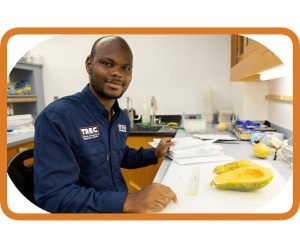What does fall feel like in South Florida? Not much different from summer, actually. Unlike the rest of the country, we don’t get cold weather or leaves changing colors to indicate this seasonal change. If it wasn’t for national chains blasting us with the burnt orange hues of pumpkin, we would stay drenched in the humidity of a Florida summer.
That combination, of wet sunshine, results in the perfect recipe for the cultivation of many of our fall favorites. If you didn’t know that pumpkin grows in South Florida, then let me introduce you to Dr. Geoffrey Meru.
Dr. Meru reports that in addition to being versatile and delicious, we should think of calabaza as a “low-calorie nutritional powerhouse”.
Why calabaza?
Dr. Meru is an assistant professor in the Horticultural Sciences Department stationed at UF/IFAS Tropical Research and Education Center (TREC) in Homestead where he studies squash and pumpkins of the Cucurbita genus. So, if anyone knows about calabaza, it’s him. Dr. Meru reports that in addition to being versatile and delicious, we should think of calabaza as a “low-calorie nutritional powerhouse”.

One of the best characteristics about calabaza is that you can consume all parts of the plant: from the leaves to the seeds. Almost everyone in South Florida adds calabaza to their red beans, white beans, or garbanzos. But, did you know that the leaves of the calabaza plant can be sauteed just like any other leafy green (think collard greens or kale)? The flesh or pulp of this pumpkin, also, can be prepared in soups or desserts. And pumpkin seeds can even be roasted and eaten as a snack. From the creamy texture of calabaza in a soup or dessert, to the hint of sweetness that calabaza adds to a savory dish, it’s no wonder why pumpkin is a fall favorite.
Moving forward
Dr. Meru predicts that pumpkins will continue gaining popularity due to their versatility, especially pumpkin seeds. Pumpkin seeds can be eaten raw or added to trail mixes, cereal blends, or even baked goods. The oil of pumpkin seeds, too, has health benefits similar to that of the soybean. Maybe most importantly, pumpkin seeds offer consumers with allergies an alternative to the growing number of nut butters on the market.
Pumpkin seeds offer consumers with allergies an alternative to the growing number of nut butters on the market.
While we daydream about all the ways we will use pumpkin this fall, Dr. Meru and his team are busy finding ways to support the pumpkins’ ability to resist diseases and insects and to support growers’ yields of this increasingly popular crop. Who knows? Maybe one day in the not too distant future, our fall will become noticeable, too. Not because of the weather or leaves changing but because of an abundant supply of locally harvested calabaza in South Florida.
 2
2
